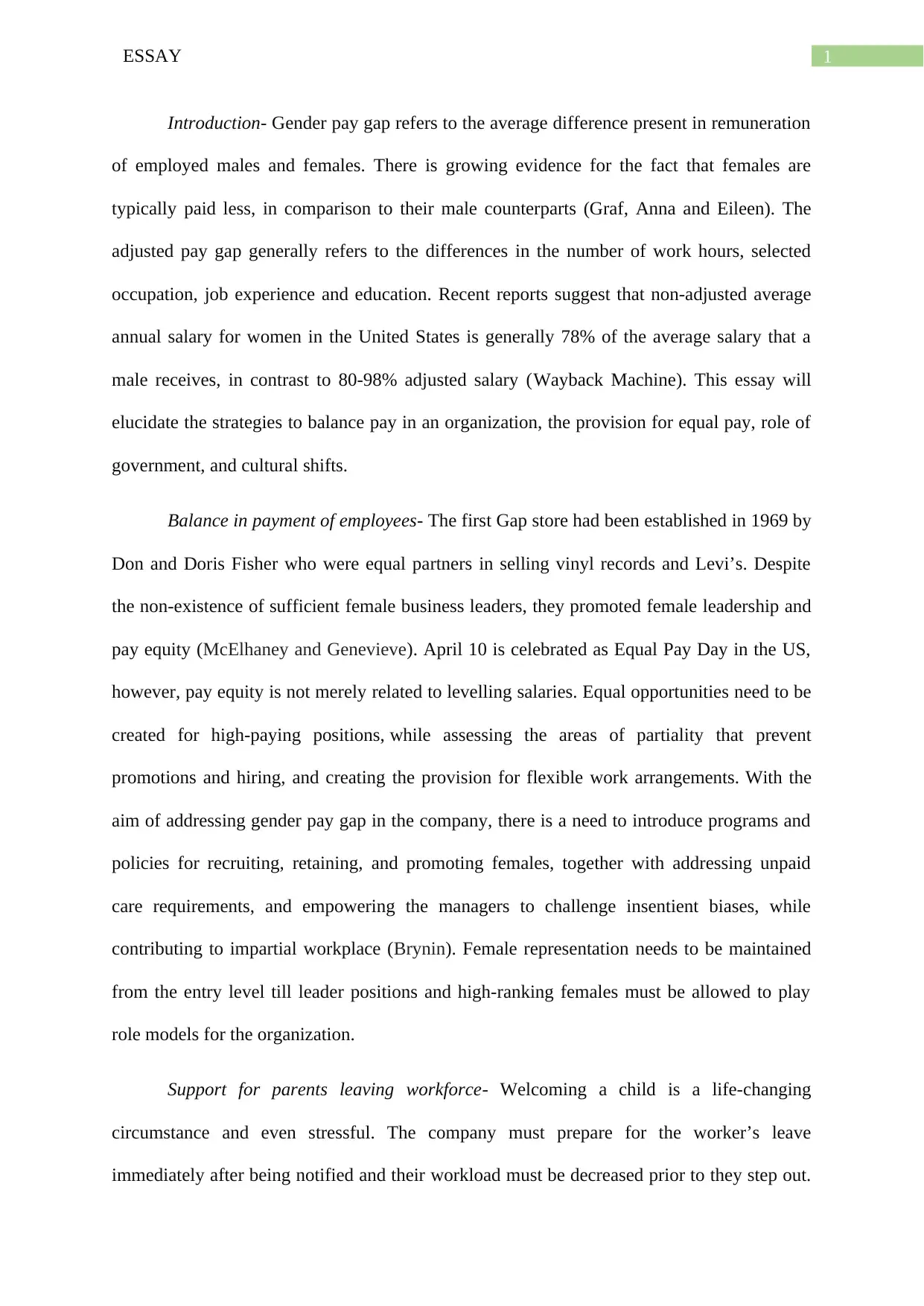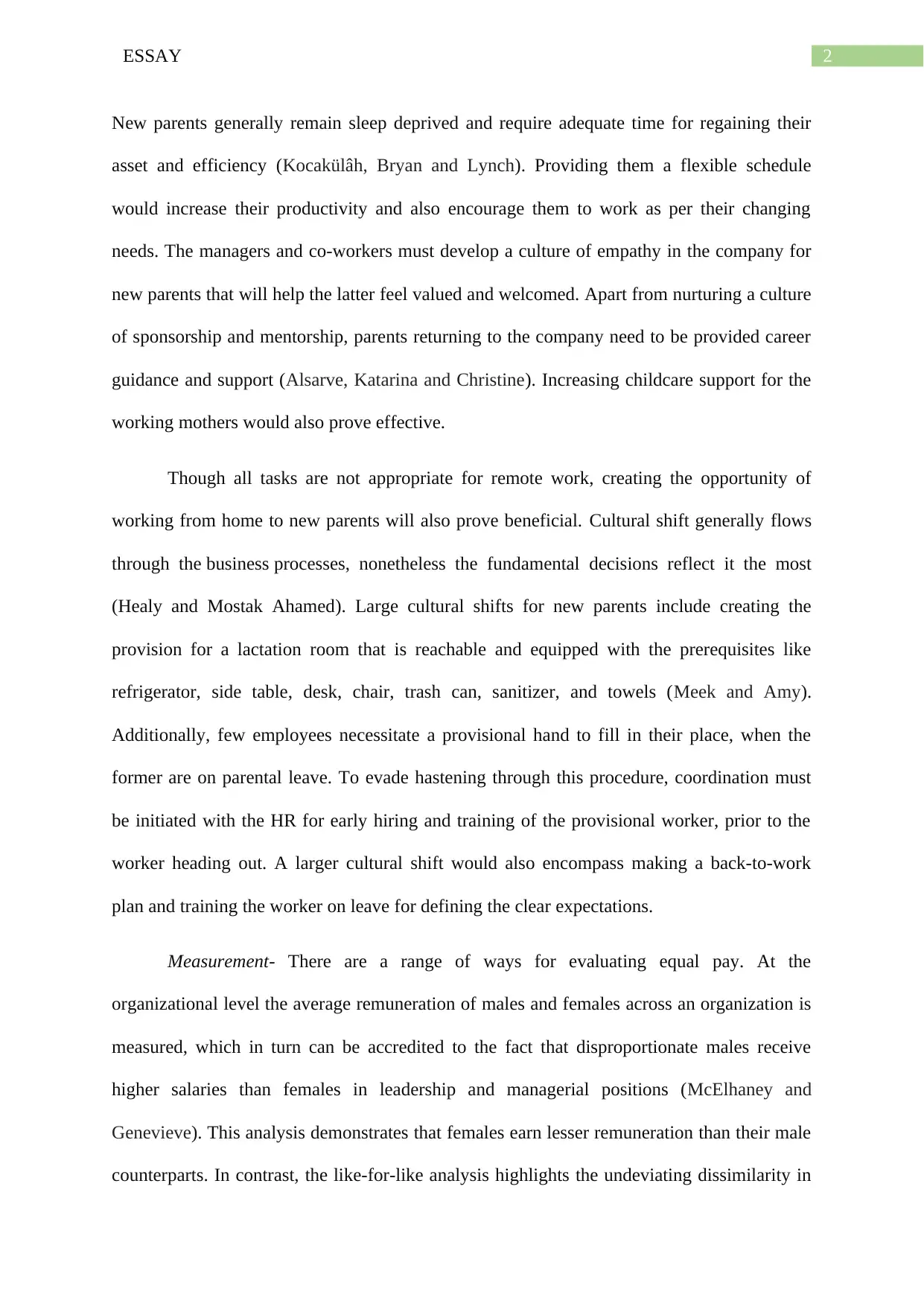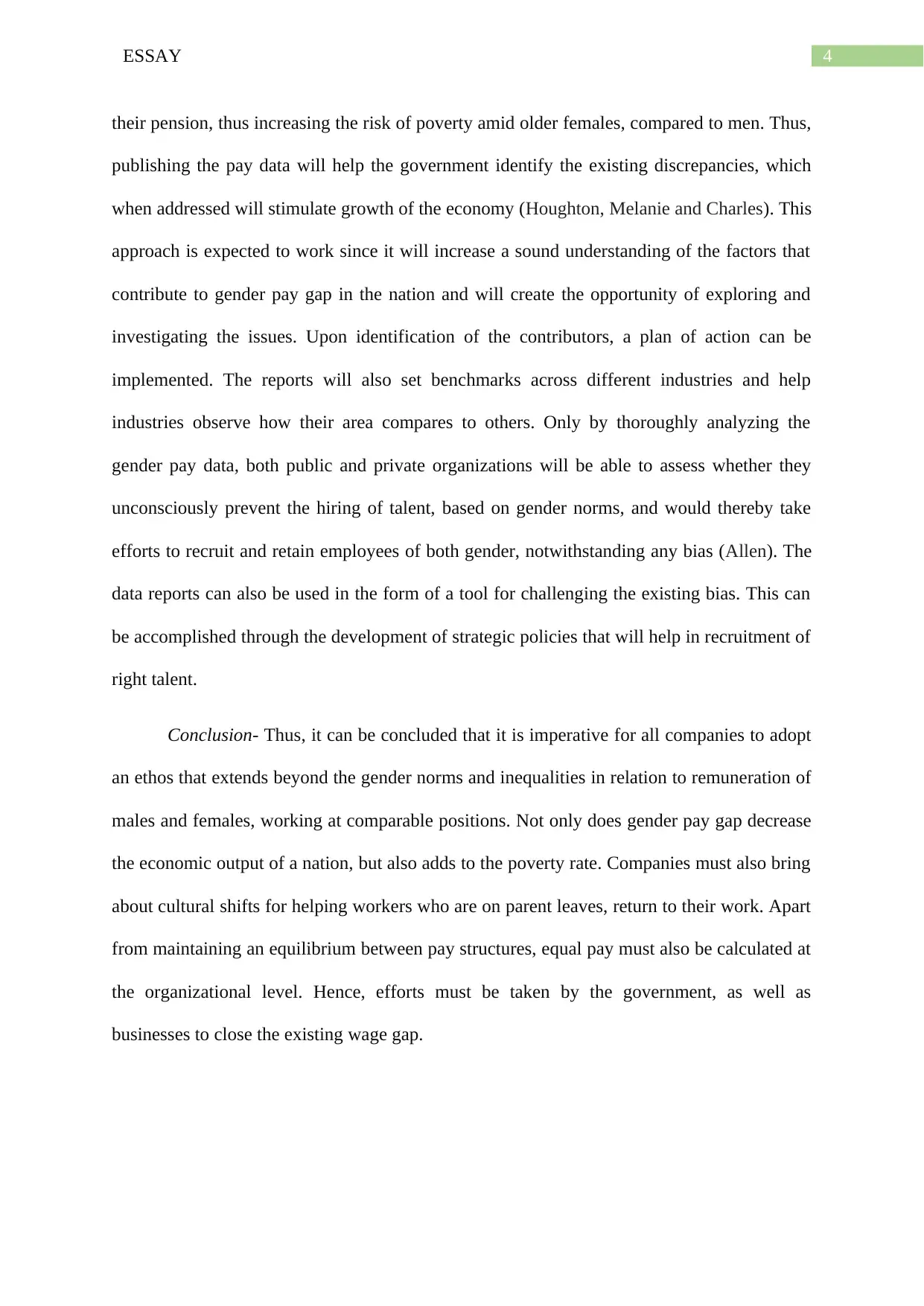Gender Pay Gap: Strategies for Equal Pay in Organizations Essay
VerifiedAdded on 2022/08/15
|7
|1958
|17
Essay
AI Summary
This essay delves into the pervasive issue of the gender pay gap, examining its definition and the disparities in remuneration between males and females. It explores strategies for achieving pay balance within organizations, including fostering equal opportunities for high-paying positions, addressing biases, and creating flexible work arrangements. The essay emphasizes the importance of supporting parents returning to work through flexible schedules, childcare support, and cultural shifts like lactation rooms. Furthermore, it analyzes methods for evaluating equal pay, considering factors like age, location, and marital status. The role of government in enforcing pay data reporting is highlighted as a means to identify and address discrepancies. The essay concludes by emphasizing the need for both governmental and organizational efforts to close the wage gap and foster an equitable work environment.

Running head: ESSAY
Gender pay gap
Name of the Student
Name of the University
Author Note
Gender pay gap
Name of the Student
Name of the University
Author Note
Paraphrase This Document
Need a fresh take? Get an instant paraphrase of this document with our AI Paraphraser

1ESSAY
Introduction- Gender pay gap refers to the average difference present in remuneration
of employed males and females. There is growing evidence for the fact that females are
typically paid less, in comparison to their male counterparts (Graf, Anna and Eileen). The
adjusted pay gap generally refers to the differences in the number of work hours, selected
occupation, job experience and education. Recent reports suggest that non-adjusted average
annual salary for women in the United States is generally 78% of the average salary that a
male receives, in contrast to 80-98% adjusted salary (Wayback Machine). This essay will
elucidate the strategies to balance pay in an organization, the provision for equal pay, role of
government, and cultural shifts.
Balance in payment of employees- The first Gap store had been established in 1969 by
Don and Doris Fisher who were equal partners in selling vinyl records and Levi’s. Despite
the non-existence of sufficient female business leaders, they promoted female leadership and
pay equity (McElhaney and Genevieve). April 10 is celebrated as Equal Pay Day in the US,
however, pay equity is not merely related to levelling salaries. Equal opportunities need to be
created for high-paying positions, while assessing the areas of partiality that prevent
promotions and hiring, and creating the provision for flexible work arrangements. With the
aim of addressing gender pay gap in the company, there is a need to introduce programs and
policies for recruiting, retaining, and promoting females, together with addressing unpaid
care requirements, and empowering the managers to challenge insentient biases, while
contributing to impartial workplace (Brynin). Female representation needs to be maintained
from the entry level till leader positions and high-ranking females must be allowed to play
role models for the organization.
Support for parents leaving workforce- Welcoming a child is a life-changing
circumstance and even stressful. The company must prepare for the worker’s leave
immediately after being notified and their workload must be decreased prior to they step out.
Introduction- Gender pay gap refers to the average difference present in remuneration
of employed males and females. There is growing evidence for the fact that females are
typically paid less, in comparison to their male counterparts (Graf, Anna and Eileen). The
adjusted pay gap generally refers to the differences in the number of work hours, selected
occupation, job experience and education. Recent reports suggest that non-adjusted average
annual salary for women in the United States is generally 78% of the average salary that a
male receives, in contrast to 80-98% adjusted salary (Wayback Machine). This essay will
elucidate the strategies to balance pay in an organization, the provision for equal pay, role of
government, and cultural shifts.
Balance in payment of employees- The first Gap store had been established in 1969 by
Don and Doris Fisher who were equal partners in selling vinyl records and Levi’s. Despite
the non-existence of sufficient female business leaders, they promoted female leadership and
pay equity (McElhaney and Genevieve). April 10 is celebrated as Equal Pay Day in the US,
however, pay equity is not merely related to levelling salaries. Equal opportunities need to be
created for high-paying positions, while assessing the areas of partiality that prevent
promotions and hiring, and creating the provision for flexible work arrangements. With the
aim of addressing gender pay gap in the company, there is a need to introduce programs and
policies for recruiting, retaining, and promoting females, together with addressing unpaid
care requirements, and empowering the managers to challenge insentient biases, while
contributing to impartial workplace (Brynin). Female representation needs to be maintained
from the entry level till leader positions and high-ranking females must be allowed to play
role models for the organization.
Support for parents leaving workforce- Welcoming a child is a life-changing
circumstance and even stressful. The company must prepare for the worker’s leave
immediately after being notified and their workload must be decreased prior to they step out.

2ESSAY
New parents generally remain sleep deprived and require adequate time for regaining their
asset and efficiency (Kocakülâh, Bryan and Lynch). Providing them a flexible schedule
would increase their productivity and also encourage them to work as per their changing
needs. The managers and co-workers must develop a culture of empathy in the company for
new parents that will help the latter feel valued and welcomed. Apart from nurturing a culture
of sponsorship and mentorship, parents returning to the company need to be provided career
guidance and support (Alsarve, Katarina and Christine). Increasing childcare support for the
working mothers would also prove effective.
Though all tasks are not appropriate for remote work, creating the opportunity of
working from home to new parents will also prove beneficial. Cultural shift generally flows
through the business processes, nonetheless the fundamental decisions reflect it the most
(Healy and Mostak Ahamed). Large cultural shifts for new parents include creating the
provision for a lactation room that is reachable and equipped with the prerequisites like
refrigerator, side table, desk, chair, trash can, sanitizer, and towels (Meek and Amy).
Additionally, few employees necessitate a provisional hand to fill in their place, when the
former are on parental leave. To evade hastening through this procedure, coordination must
be initiated with the HR for early hiring and training of the provisional worker, prior to the
worker heading out. A larger cultural shift would also encompass making a back-to-work
plan and training the worker on leave for defining the clear expectations.
Measurement- There are a range of ways for evaluating equal pay. At the
organizational level the average remuneration of males and females across an organization is
measured, which in turn can be accredited to the fact that disproportionate males receive
higher salaries than females in leadership and managerial positions (McElhaney and
Genevieve). This analysis demonstrates that females earn lesser remuneration than their male
counterparts. In contrast, the like-for-like analysis highlights the undeviating dissimilarity in
New parents generally remain sleep deprived and require adequate time for regaining their
asset and efficiency (Kocakülâh, Bryan and Lynch). Providing them a flexible schedule
would increase their productivity and also encourage them to work as per their changing
needs. The managers and co-workers must develop a culture of empathy in the company for
new parents that will help the latter feel valued and welcomed. Apart from nurturing a culture
of sponsorship and mentorship, parents returning to the company need to be provided career
guidance and support (Alsarve, Katarina and Christine). Increasing childcare support for the
working mothers would also prove effective.
Though all tasks are not appropriate for remote work, creating the opportunity of
working from home to new parents will also prove beneficial. Cultural shift generally flows
through the business processes, nonetheless the fundamental decisions reflect it the most
(Healy and Mostak Ahamed). Large cultural shifts for new parents include creating the
provision for a lactation room that is reachable and equipped with the prerequisites like
refrigerator, side table, desk, chair, trash can, sanitizer, and towels (Meek and Amy).
Additionally, few employees necessitate a provisional hand to fill in their place, when the
former are on parental leave. To evade hastening through this procedure, coordination must
be initiated with the HR for early hiring and training of the provisional worker, prior to the
worker heading out. A larger cultural shift would also encompass making a back-to-work
plan and training the worker on leave for defining the clear expectations.
Measurement- There are a range of ways for evaluating equal pay. At the
organizational level the average remuneration of males and females across an organization is
measured, which in turn can be accredited to the fact that disproportionate males receive
higher salaries than females in leadership and managerial positions (McElhaney and
Genevieve). This analysis demonstrates that females earn lesser remuneration than their male
counterparts. In contrast, the like-for-like analysis highlights the undeviating dissimilarity in
⊘ This is a preview!⊘
Do you want full access?
Subscribe today to unlock all pages.

Trusted by 1+ million students worldwide

3ESSAY
the income that males and females earn in comparable professions, which in turn is much
lesser once the management gap is considered (Warner and Lisa). However, it is particularly
difficult to define occupations that are of comparable or equal value, and this analysis fails to
account for the unsolved gender pay gap that continues even after adjustment of the
measurable factors like tenancy, age, geography and juniors. Thus, it can be suggested that
the organizational pay gap analysis is best suited for examination of pay. Some factors in
compensation that need to be assessed for pay reviews are namely, age, location, race, marital
status and sexual orientation. The disparity in salary between males and females increases
with an increase in age and as years go by, the gap becomes more (Chamberlain).
With an increase in age amid women, they earn lesser percentage of the salary of their
male counterparts. While females of color have been found to fare superior, when compared
to their white females comparative to males of the similar ethnicity like African-American
males and females, or Asian males and females, in contrast to white males and females, they
receive less salary than white females in general (Mize). Moreover, the place of residence
also affects the gender pay with women working remotely demonstrating an increased
likelihood of obtaining less remuneration than men. Recent evidences have also elaborated on
the fact that bisexual males and females make less money, in contrast to their gender
confirming counterparts (Bryson). Additionally, marital status must also be analyzed in pay
reviews owing to the fact that males are expected to adorn the role of primary breadwinners
for their family members. Hence, females acquire more salary when they are unmarried,
while males receive more remuneration when married (Katz).
Pay data publishing- With the aim of tackling the existing gender pay gaps, the
government has enforced new legislation for reporting the pay data. It can be cited as the role
of the government owing to the fact that an increase in gender pay gap results in a reduction
in the GDP per capita of the nation. Moreover, lesser lifetime earnings of women decreases
the income that males and females earn in comparable professions, which in turn is much
lesser once the management gap is considered (Warner and Lisa). However, it is particularly
difficult to define occupations that are of comparable or equal value, and this analysis fails to
account for the unsolved gender pay gap that continues even after adjustment of the
measurable factors like tenancy, age, geography and juniors. Thus, it can be suggested that
the organizational pay gap analysis is best suited for examination of pay. Some factors in
compensation that need to be assessed for pay reviews are namely, age, location, race, marital
status and sexual orientation. The disparity in salary between males and females increases
with an increase in age and as years go by, the gap becomes more (Chamberlain).
With an increase in age amid women, they earn lesser percentage of the salary of their
male counterparts. While females of color have been found to fare superior, when compared
to their white females comparative to males of the similar ethnicity like African-American
males and females, or Asian males and females, in contrast to white males and females, they
receive less salary than white females in general (Mize). Moreover, the place of residence
also affects the gender pay with women working remotely demonstrating an increased
likelihood of obtaining less remuneration than men. Recent evidences have also elaborated on
the fact that bisexual males and females make less money, in contrast to their gender
confirming counterparts (Bryson). Additionally, marital status must also be analyzed in pay
reviews owing to the fact that males are expected to adorn the role of primary breadwinners
for their family members. Hence, females acquire more salary when they are unmarried,
while males receive more remuneration when married (Katz).
Pay data publishing- With the aim of tackling the existing gender pay gaps, the
government has enforced new legislation for reporting the pay data. It can be cited as the role
of the government owing to the fact that an increase in gender pay gap results in a reduction
in the GDP per capita of the nation. Moreover, lesser lifetime earnings of women decreases
Paraphrase This Document
Need a fresh take? Get an instant paraphrase of this document with our AI Paraphraser

4ESSAY
their pension, thus increasing the risk of poverty amid older females, compared to men. Thus,
publishing the pay data will help the government identify the existing discrepancies, which
when addressed will stimulate growth of the economy (Houghton, Melanie and Charles). This
approach is expected to work since it will increase a sound understanding of the factors that
contribute to gender pay gap in the nation and will create the opportunity of exploring and
investigating the issues. Upon identification of the contributors, a plan of action can be
implemented. The reports will also set benchmarks across different industries and help
industries observe how their area compares to others. Only by thoroughly analyzing the
gender pay data, both public and private organizations will be able to assess whether they
unconsciously prevent the hiring of talent, based on gender norms, and would thereby take
efforts to recruit and retain employees of both gender, notwithstanding any bias (Allen). The
data reports can also be used in the form of a tool for challenging the existing bias. This can
be accomplished through the development of strategic policies that will help in recruitment of
right talent.
Conclusion- Thus, it can be concluded that it is imperative for all companies to adopt
an ethos that extends beyond the gender norms and inequalities in relation to remuneration of
males and females, working at comparable positions. Not only does gender pay gap decrease
the economic output of a nation, but also adds to the poverty rate. Companies must also bring
about cultural shifts for helping workers who are on parent leaves, return to their work. Apart
from maintaining an equilibrium between pay structures, equal pay must also be calculated at
the organizational level. Hence, efforts must be taken by the government, as well as
businesses to close the existing wage gap.
their pension, thus increasing the risk of poverty amid older females, compared to men. Thus,
publishing the pay data will help the government identify the existing discrepancies, which
when addressed will stimulate growth of the economy (Houghton, Melanie and Charles). This
approach is expected to work since it will increase a sound understanding of the factors that
contribute to gender pay gap in the nation and will create the opportunity of exploring and
investigating the issues. Upon identification of the contributors, a plan of action can be
implemented. The reports will also set benchmarks across different industries and help
industries observe how their area compares to others. Only by thoroughly analyzing the
gender pay data, both public and private organizations will be able to assess whether they
unconsciously prevent the hiring of talent, based on gender norms, and would thereby take
efforts to recruit and retain employees of both gender, notwithstanding any bias (Allen). The
data reports can also be used in the form of a tool for challenging the existing bias. This can
be accomplished through the development of strategic policies that will help in recruitment of
right talent.
Conclusion- Thus, it can be concluded that it is imperative for all companies to adopt
an ethos that extends beyond the gender norms and inequalities in relation to remuneration of
males and females, working at comparable positions. Not only does gender pay gap decrease
the economic output of a nation, but also adds to the poverty rate. Companies must also bring
about cultural shifts for helping workers who are on parent leaves, return to their work. Apart
from maintaining an equilibrium between pay structures, equal pay must also be calculated at
the organizational level. Hence, efforts must be taken by the government, as well as
businesses to close the existing wage gap.

5ESSAY
References
Allen, Phil. "Mind the gap: Gender pay reporting and what it means for employers." Practice
Management 26.3 (2016): 24-25.
Alsarve, Jenny, Katarina Boye, and Christine Roman. "Realized plans or revised dreams?
Swedish parents experiences of care, parental leave and paid work after
childbirth." New Parents in Europe. Edward Elgar Publishing, 2019.
Brynin, Malcolm. "The gender pay gap." Equality and Human Rights Commission Research
Report 109 (2017).
Bryson, Alex. "Pay equity after the Equality Act 2010: does sexual orientation still
matter?." Work, employment and society 31.3 (2017): 483-500.
Chamberlain, Andrew. "Demystifying the gender pay gap." Mill Valley, CA:
Glassdoor (2016).
Graf, Nikki, Anna Brown, and Eileen Patten. "The narrowing, but persistent, gender gap in
pay." Pew Research Center, April 9 (2018).
Healy, Geraldine, and M. Mostak Ahamed. "Gender pay gap, voluntary interventions and
recession: the case of the British financial services sector." British Journal of
Industrial Relations 57.2 (2019): 302-327.
Houghton, Edward, Melanie Green, and Charles Cotton. "Not just a number: lessons from the
first year of gender pay gap reporting." (2019).
Katz, Batia. Parenthood, Partnership, and Pay: The Effect of Family Responsibility on the
Gender Wage Gap in Science and Engineering. Diss. 2019.
References
Allen, Phil. "Mind the gap: Gender pay reporting and what it means for employers." Practice
Management 26.3 (2016): 24-25.
Alsarve, Jenny, Katarina Boye, and Christine Roman. "Realized plans or revised dreams?
Swedish parents experiences of care, parental leave and paid work after
childbirth." New Parents in Europe. Edward Elgar Publishing, 2019.
Brynin, Malcolm. "The gender pay gap." Equality and Human Rights Commission Research
Report 109 (2017).
Bryson, Alex. "Pay equity after the Equality Act 2010: does sexual orientation still
matter?." Work, employment and society 31.3 (2017): 483-500.
Chamberlain, Andrew. "Demystifying the gender pay gap." Mill Valley, CA:
Glassdoor (2016).
Graf, Nikki, Anna Brown, and Eileen Patten. "The narrowing, but persistent, gender gap in
pay." Pew Research Center, April 9 (2018).
Healy, Geraldine, and M. Mostak Ahamed. "Gender pay gap, voluntary interventions and
recession: the case of the British financial services sector." British Journal of
Industrial Relations 57.2 (2019): 302-327.
Houghton, Edward, Melanie Green, and Charles Cotton. "Not just a number: lessons from the
first year of gender pay gap reporting." (2019).
Katz, Batia. Parenthood, Partnership, and Pay: The Effect of Family Responsibility on the
Gender Wage Gap in Science and Engineering. Diss. 2019.
⊘ This is a preview!⊘
Do you want full access?
Subscribe today to unlock all pages.

Trusted by 1+ million students worldwide

6ESSAY
Kocakülâh, Mehmet C., T. G. Bryan, and S. Lynch. "Effects of absenteeism on company
productivity, efficiency, and profitability." Business and Economic Research 8.1
(2018): 115-135.
McElhaney, Kellie, and Genevieve Smith. Eliminating the gender pay gap: Gap Inc. leads
the way. The Berkeley-Haas Case Series. University of California, Berkeley. Haas
School of Business, 2017.
Meek, Joan Younger, and Amy J. Hatcher. "The breastfeeding-friendly pediatric office
practice." Pediatrics 139.5 (2017).
Mize, Trenton D. "Sexual orientation in the labor market." American Sociological
Review 81.6 (2016): 1132-1160.
Warner, A. Sofia, and Lisa Soleymani Lehmann. "Gender wage disparities in medicine: time
to close the gap." Journal of general internal medicine 34.7 (2019): 1334-1336.
Wayback Machine. Web.Archive.Org, 2020,
https://web.archive.org/web/20170224051057/https://www.aauw.org/aauw_check/
pdf_download/show_pdf.php?file=The-Simple-Truth.
Kocakülâh, Mehmet C., T. G. Bryan, and S. Lynch. "Effects of absenteeism on company
productivity, efficiency, and profitability." Business and Economic Research 8.1
(2018): 115-135.
McElhaney, Kellie, and Genevieve Smith. Eliminating the gender pay gap: Gap Inc. leads
the way. The Berkeley-Haas Case Series. University of California, Berkeley. Haas
School of Business, 2017.
Meek, Joan Younger, and Amy J. Hatcher. "The breastfeeding-friendly pediatric office
practice." Pediatrics 139.5 (2017).
Mize, Trenton D. "Sexual orientation in the labor market." American Sociological
Review 81.6 (2016): 1132-1160.
Warner, A. Sofia, and Lisa Soleymani Lehmann. "Gender wage disparities in medicine: time
to close the gap." Journal of general internal medicine 34.7 (2019): 1334-1336.
Wayback Machine. Web.Archive.Org, 2020,
https://web.archive.org/web/20170224051057/https://www.aauw.org/aauw_check/
pdf_download/show_pdf.php?file=The-Simple-Truth.
1 out of 7
Related Documents
Your All-in-One AI-Powered Toolkit for Academic Success.
+13062052269
info@desklib.com
Available 24*7 on WhatsApp / Email
![[object Object]](/_next/static/media/star-bottom.7253800d.svg)
Unlock your academic potential
Copyright © 2020–2025 A2Z Services. All Rights Reserved. Developed and managed by ZUCOL.




